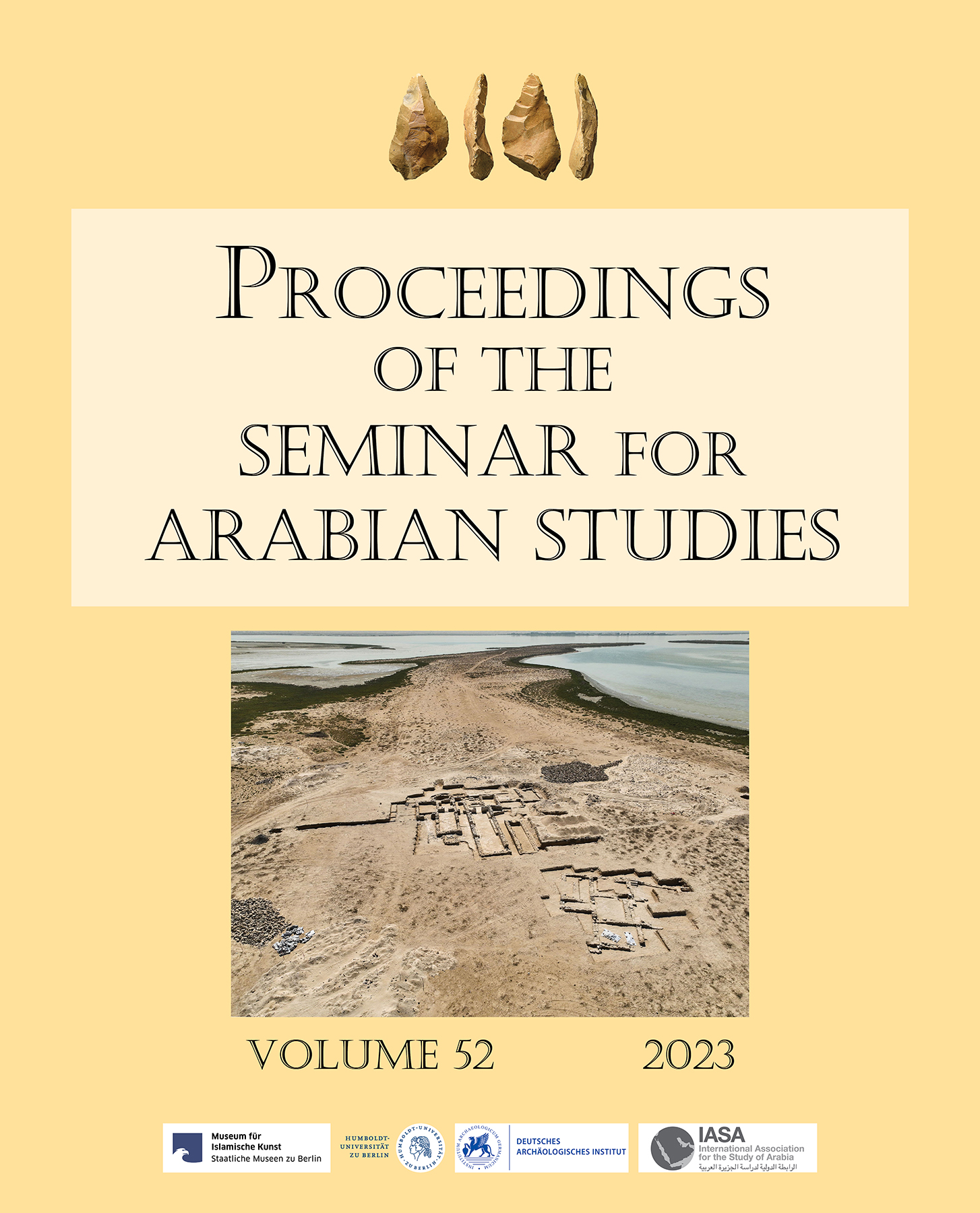Fulayj A Sasanian and Early Islamic Fort in the Sohar Hinterland
Abstract
Fulayj fort is located on the fertile Batinah plain of Oman, 12km inland from Saham and 32km southeast of the key urban centre and major medieval port of Sohar. The chance discovery of the site by Nasser Al-Jahwari in 2012, provided an important breakthrough in our potential understanding of the late pre-Islamic and initial Islamic period occupation in Oman. Finds collected during the first survey of the site were inspected by Derek Kennet and recognised as likely to be of late Sasanian or very early Islamic date. Following further recording in 2014, a broad, multidisciplinary archaeological investigation was launched in 2015. Two seasons were completed by a joint British-Omani team in 2015 and 2016. Following a break in operations, a third season of fieldwork was completed in 2022. These investigations have confirmed the initial dating of the fort and substantially enhanced our understanding of all aspects of its planning, construction, history of occupation, internal organisation, nature of use, etc. It is possible that Fulayj formed part of a wider defensive military cordon protecting the commercial and agricultural potential of the fertile coastal strip and urban centre of the Sohar region. These wider aspects will be returned to again for further consideration below.
References
Bosworth C.E. 1999. The History of al-Tabari. Volume V. The Sasanids, the Byzantines, the Lakhmids, and Yemen. Albany (NY): Bibliotheca Persica.
Dabrowski V., Ros J., Tengberg M. & Rougeulle A. 2015. De l’origine et de l’utilisation des ressources végétales en Oman médiéval: première étude archéobotanique à Qalhât. Routes de l’Orient 2: 1–13.
Dabrowski V., Tengberg M., Creissen T. & Rougeulle A. 2018. Plant supplying strategies in an Islamic Omani harbour city: archaeobotanical analysis from a workshop (B39) in Qalhât (XIVth-XVIth c. AD). Journal of Islamic Archaeology 5: 17–38.
Dabrowski V., Bouchaud C., Tengberg M., Zazzo A. & Priestman S. 2021a. Archaeobotanical analysis of food and fuel procurement from Fulayj fort (Oman, 5th-8th c. CE) including the earliest secure evidence for sorghum in Eastern Arabia. Journal of Arid Environments 190: 104512 https://doi.org/10.1016/j.jaridenv.2021.104512
Dabrowski, V. Bouchaud C., Tengberg M. & Mouton M. 2021b. Crop processing, consumption and trade of Asian rice (Oryza sativa L.) in the Arabian Peninsula during Antiquity: earliest evidence from Mleiha (third c. AD), United Arab Emirates. Archaeological & Anthropological Sciences 00: 1-19. https://doi.org/10.1007/s12520-021-01277-5
Dabrowski V., Tengberg M., Parker A. & Kennet D. Forthcoming. Agricultural economy, plant use and trade on the Sasanian and Islamic site of Kush (Ra’s al-Khaimah’s Emirate, U.A.E). Vegetation History and Archaeobotany.
Huyse P. 1999. Die dreisprachige Inschrift Š¯abuhrs I. an der Ka‘ba-i Zardušt (2 volumes). London: School of African and Oriental Studies.
Al-Jahwari N., Kennet D., Priestman S. & Sauer E. 2018. Fulayj: a late Sasanian fort on the Arabian coast. Antiquity 92(363): 724–41. https://doi.org/10.15184/aqy.2018.64
Kennedy H. 2007. The Great Arab Conquests. How the spread of Islam changed the world we live in. London: Weidenfeld & Nicolson.
Kennet D. 2004. Sasanian and Islamic Pottery from Ras al-Khaimah: Classification Chronology and Analysis of Trade in the Western Indian Ocean. Oxford: British Archaeological Reports (International Series) 1248/Society for Arabian Studies Monographs 1.
Kennet D. 2007. The decline of Eastern Arabia in the Sasanian period. Arabian Archaeology and Epigraphy 18: 86–122. https://doi.org/10.1111/j.1600-0471.2007.00274.x
Munt H. 2017. Oman and late Sasanian imperialism, Arabian Archaeology & Epigraphy 28: 264–284.
Priestman S.M.N. 2019. The archaeology of early Islam in Oman: recent discoveries from Fulayj on the Batinah. The Anglo-Omani Society Review 2019: 40–43.
Priestman S.M.N. 2021. Ceramic Exchange and the Indian Ocean Economy (AD 400-1275). Vol. I: Analysis. London: British Museum Research Publication 223. https://doi.org/10.48582/ceramicexchange_vol1
Priestman S.M.N. 2021. Ceramic Exchange and the Indian Ocean Economy (AD 400-1275). Vol. II: Indian Ocean Pottery Classification. London: British Museum Research Publication 223. https://doi.org/10.48582/CERAMICEXCHANGE_VOL2
Tengberg M., Dabrowski V. & Kennet D. Forthcoming. Vegetation history and wood exploitation at Kush (Ras al-Khaimah, UAE), 4th-17th/18th centuries AD. First results of the charcoal analysis. Arabian Archaeology & Epigraphy.
Published
How to Cite
Issue
Section
License
Archaeopress Publishing, Oxford, UK


